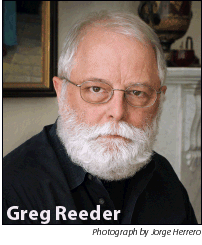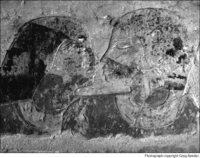A WHITE CRANE CONVERSATION
Dan Vera chats with Egyptologist Greg Reeder about the Importance of Honoring the Past of Same-Sex Love.
In 1964 in the ancient necropolis of Saqqara, the Egyptian archaeologist Ahmed Moussa discovered a series of tombs with rock-cut passages in the escarpment facing the causeway that lead to the pyramid of Unas. Soon after, the Chief Inspector Mounir Basta reported crawling on his hands and knees through the passages, entering one of the Old Kingdom tombs. He was impressed with its unique scenes of two men in intimate embrace, something he had never seen before in all the Saqqara tombs.
Meanwhile, archaeologists working on the restoration of the causeway of Unas discovered that some of the stone blocks that had been used to build the causeway had been appropriated in ancient times from the mastaba that had originally served as the entrance to this newly discovered tomb. The archaeologists reconstructed the mastaba using the inscribed blocks found in the substructure of the causeway. It was revealed that this unique tomb had been built for two men to cohabit and that both shared identical titles in the palace of King Niuserre of the Fifth Dynasty: “Overseer Of The Manicurists In The Palace Of The King.”
 Inside the tomb the names of Niankhkhnum and Khnumhotep are inscribed as one name over the doorway. In the deepest part of the tomb the identical pair are shown in the most intimate embrace possible within the canons of ancient Egyptian art. The tips of the men’s noses are touching and their torsos are so close together that the knots on the belts of their kilts appear to be touching, perhaps even tied together. Here, in the innermost private part of their joint-tomb, the two men stand in an embrace meant to last for eternity.
Inside the tomb the names of Niankhkhnum and Khnumhotep are inscribed as one name over the doorway. In the deepest part of the tomb the identical pair are shown in the most intimate embrace possible within the canons of ancient Egyptian art. The tips of the men’s noses are touching and their torsos are so close together that the knots on the belts of their kilts appear to be touching, perhaps even tied together. Here, in the innermost private part of their joint-tomb, the two men stand in an embrace meant to last for eternity.
The scholar Greg Reeder has done a great deal of writing about the importance of Niankhkhnum and Khnumhotep. White Crane spoke with him about these ancient forebears.
Dan Vera:
What do you think the significance of Niankhkhnum and Khnumhotep is to Gay people? What can we learn from the ancient world?
Greg Reeder:
It is important for Gay people to know that love between two men was beautifully portrayed in an ancient tomb of the 5th Dynasty in Old Kingdom Egypt. We need to understand that family could be more diverse than so-called normative, present day definitions. Niankhkhnum and Khnumhotep were both married to women and had children, but they were still able to share a degree of intimacy that in other circumstances was only shown between husband and wife. Their family not only included their wives and children, but each other. The images of them embracing and kissing are stunning reminders that the ancient world has much to teach us about where we have come from; the ways people adapted to the rules of society and yet were still able to express their same-sex devotions.
Vera:
How did you get involved with his area of study?
 Reeder:
Reeder:
In 1981 I made my first trip to Egypt with my friend Michael Crisp. We spent two months there in the hopes of gathering material for a book on Egypt’s “sacred geography” – a book that never happened. Before I went to Egypt I was interested in the tomb of Niankhkhnum and Khnumhotep because I had seen it referenced in a travel book, which declared that there were scenes of two men embracing each other. We tried unsuccessfully to visit the tomb in 1981. Sometime in the year or so following our visit, I approached Mark Thompson about the possibility of doing a story for the Advocate about the tomb. He was enthusiastic in reply and I set about writing the article and gathering some photographs. The article was published May of 1983. So Mark Thompson gave me my first opportunity to write about the two manicurists.
Vera:
You’ve also written about Niankhkhnum and Khnumhotep in KMT, the modern journal of Ancient Egypt. Have other publications carried your research?
Reeder:
My friend Dennis Forbes, who also had worked for The Advocate, started KMT in 1990 with Michael Kuhlmann. I was involved as staff photographer and then as a contributing editor. Dennis asked me to write a piece for KMT on Niankhkhnum and Khnumhotep, which was published in KMT in 1993. I also published a paper on the tomb in World Archeology titled “Same-Sex Desire, Conjugal Constructs, and the Tomb of Niankhkhnum and Khnumhotep.”
Vera:
Do you think the case for Niankhkhnum and Khnumhotep as lovers is a solid one?
Reeder:
I think it a good one but one that needs to be discussed and debated. The ancient Egyptians of the Old Kingdom had a canon of art they used to depict the conjugal relationship between husband and wife.
My paper for World Archaeology goes into much detail about this. But, simply put, the ways the two men were portrayed embracing has its best parallels to those scenes of husband and wife embracing in other tombs of the period and I use examples from these other tombs to make the case. No matter what the biological relationship of the two men, there can be no doubt that they were expressing a profound intimacy and attraction that may best be described as “lovers.”
This is just an excerpt from this issue of White Crane. We are a reader-supported journal and need you to subscribe to keep this conversation going. So to read more from this wonderful issue SUBSCRIBE to White Crane. Thanks!
For more on Greg Reeder and to see more images from the tomb of Niankhkhnum and Khnumhotep, please visit www.egyptology.com
